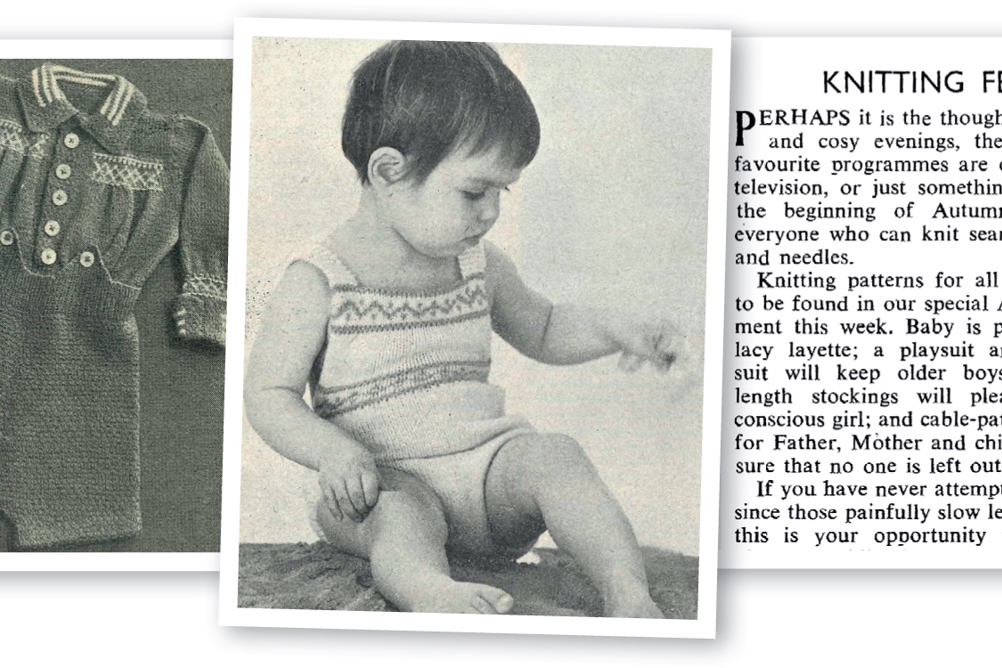
Generations have been kitted out in knitted creations taken from the pages of Nursery World – a teenage jerkin for ‘Junior Miss’ to wear with her new spring outfit (21 March 1946) and plentiful woolly sunsuits, including a knitted two-piece with ‘bright red trunks with a gay diamond pattern in white and a lacy sun-top which can be buttoned on for protection against the sun’ (27 July 1966), along with jumpers and cardigans galore.
In 1947, there was a Nursery World Knitting Book and, in 1964, a supplement dedicated to patterns for all the family: ‘Baby is provided with a lacy layette; a playsuit and an outdoor suit will keep older boys warm; knee-length stockings will please a fashion-conscious girl; and cable-patterned sweaters for Father, Mother and children to make sure no-one is left out.’
 But that all changed in 1982 when Nursery World's publishers instructed the editorial team to concentrate on early years professionals and leave monthly consumer magazines to cater for parents. It was the death knell for knitting patterns. Seven years later, a reader asking for them to be reinstated was bluntly told by the editor that ‘knitting patterns would now be totally inappropriate for our magazine’ (12 January 1989). Regardless, to this day the editorial team still occasionally receive requests for misplaced patterns.
But that all changed in 1982 when Nursery World's publishers instructed the editorial team to concentrate on early years professionals and leave monthly consumer magazines to cater for parents. It was the death knell for knitting patterns. Seven years later, a reader asking for them to be reinstated was bluntly told by the editor that ‘knitting patterns would now be totally inappropriate for our magazine’ (12 January 1989). Regardless, to this day the editorial team still occasionally receive requests for misplaced patterns.
BENEFICIAL CRAFT
When Nursery World launched, knitting was a regular past-time, but as clothing became cheaper and more widely available, fewer people knitted out of necessity. There was also a move away from traditional domestic skills, and knitting as a hobby started to lost its appeal.
In recent decades there has been a resurgence in knitting and arts and crafts in general, but it has always been championed in the early years. Friedrich Froebel (1782-1852), while not explicitly mentioning knitting, emphasised the importance of creative activities, as they nurture the whole child, physically, intellectually, socially and emotionally – and that continues to be relevant today.
The range of benefits children gain from engaging in crafting is regularly highlighted in Nursery World, including sewing (‘Get set to sew!’, 1 August 2023) and pottery (‘All about…clay’, 30 January 2024).
Early years consultant Penny Tassoni noted on 16 October 2017, ‘Years ago, most children would have seen a range of everyday arts and crafts taking place in their home or in their local neighbourhood. Today many children only ever see finished products in shops and so miss learning about the processes involved.’
Learning skills like knitting links to the promotion of sustainability as children learn how to make and repair clothing. It is also an opportunity to challenge gender stereotypes. Knitting is not just a nostalgic nod to the past. It continues to help connect children to the world around them.
Knitting fever
‘If you have ever attempted any knitting since those painfully slow lessons in school, this is your opportunity to find a new pleasure, while the new wools and yarns that come out every season provide interest for the veteran knitter. Not only does knitting give the satisfaction of creating a garment yourself, it makes it possible to keep the family warm and smart at much less than the cost of ready-made clothes.’ 17 September 1964

Nursery World, 17 September, 1964
Doing fine
‘It would appear that knitting is popular again. Fashionable cafes host knitting groups, courses are widely available and the clicking of needles can be heard in trendier pubs…
‘A professor of surgical education stated in a BBC report (October 2018) that… many young people have had such limited experience of learning craft skills that they struggle with the practical aspects essential to work.’
18 March 2019









